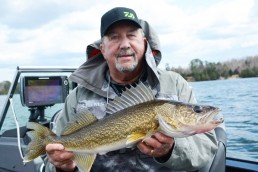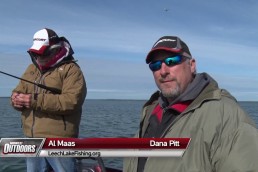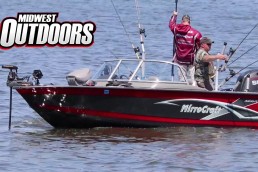Use Lighter Jigs for Walleye Success
SHARE THIS POST
The Proof
It happened again, just like on the last Minnesota Walleye Opener, and the one before that. We were square dancing amongst dozens of other boats, all over a giant piece of structure, dipping jigs. I’m not bragging, but like last time, and the time before that, our catch rate trumped the dance floor. Soon, other boats orbited us like moons circling a planet. Elbow room tightened, but we continued hauling in walleye after walleye while the invaders struggled to scoop up our scraps. I believe this all because we use lighter jigs for walleye success.
The “tail-pipers” appeared to be using similar jigs draped with live shiners, too. But still, the barrel of our landing net stayed hot while they drifted by fishless—the difference not being what they were using, but rather how they presented it.
Jigging is an interpretive act: You pitch it out there, beginning with a simple lift, fall and retrieve action, paying acute attention to how fish respond—and then reacting accordingly. In this instance, experimentation was easy going, because everyone knew walleyes were there and feeding. But what most anglers lacked was the intuitiveness and flexibility to change jigging motions and cadences until finding that perfect presentation.
Typically, anglers fish jigs that are too heavy. We drifted and backtrolled in 16 to 18 feet of water, dunking only 1/8-ounce jigs. When the wind died, we downsized to weensy 1/16-ounce lead heads. That degree of lightness puts the control in your hands, not gravity’s. Upping to a 1/4- or 3/8-ounce head would have forced us to fish nearer the boat, perhaps directly below, and not be able to tender that loft-and-glide motion that was the order of the day.
The walleyes wanted it away from the boat and sailing softly, not banging the bottom. Using smaller jigs not only caters to the preferences of inactive or cold-water walleyes, but also teaches you how to fish tiny and with total control. Heavy jigs write their own rules. Light ones make you the boss.
Slow Down
Other parts of the formula include jig and boat speed. At times, anglers fish too fast; boats sped past us, rods snapping like bullwhips. Those guys seldom got chomped. And if they did, it was a nip and a miss, maybe never knowing something kissed the bait until they later inspected the gashes on the back of the minnow.
Slow down and fish with patience, especially if you’re on top of walleyes. Generally speaking, in depths over 12 to 15 feet, I won’t even stop and drop until I see marks on the Humminbird. There are times when you need to search with a jig, especially on days when fish glued to the bottom scarcely traceable on the depth sounder screen. But if they’re up and feeding, those beautiful black thumbnails will be recognizable on the screen.
Casting
These premises pertain to casting as well. When lake conditions flatten out, I prefer pitching jigs to slow trolling. While slow trolling lead heads off the stern, whoever’s occupying the bow or mid-ship can cast and retrieve it, flaring our total area of coverage. The caster is also able to manipulate jig speed better and test various motions, like dragging and popping.
Most often, though, the caster is successful imparting that same methodical gliding action. If the minnow is hooked lightly, through the lips only, it becomes an active member of the drama. Just let the jig drag around, minnow struggling on the hook, and occasionally letting the jig settle on the bottom. No lie: Done with patience, a single cast and retrieve can take a full minute, even two.
Often, actual bites don’t materialize like the definitive “strike”—a jarring jerk on the rod. Like a bass squeals away with a soft plastic bait, a walleye will bite down on the minnow and start swimming off as if he’d scored an easy meal. You’ll feel a gradual loading of the rod tip. Paying close visual attention to the line, you might see it take an irregular path with zero pressure on the rod.
About any jig with a piercing hook does the job, but I do have preferences. Lately, many anglers are having success with VMC’s Neon Moon Eye jig. It features a surgically sharp hook that impregnates the jaw of a walleye with exact precision. But what gives the Neon Moon Eye jig that added flair are oversized, fishlike eyeballs. A small minnow yields a juicier appearance because of the bulging, realistic peepers. One heck of an appeal with plastic draped in the back gives the walleye an option of two meal choices.
Are you enjoying this post?
You can be among the first to get the latest info on where to go, what to use and how to use it!
When to Go Light
The best periods to employ this subtler, finesse approach to jigging, are in the late spring, early summer and then again in the fall. During those periods, baitfish—young perch, shiners, and shad—range shallower. In search mode, start exploring that 6 to 8-foot zone and gradually work deeper. Explore areas featuring rocks and weeds first. Shorelines that are more productive if they’ve been absorbing winds for several days in a row, driving food into them. Another trick is fishing where you see loons or other minnow-eating waterfowl in the vicinity, diving and dipping below the surface of the water. Nine gives you ten that they’re feasting on baitfish.
Boat control begins with the watercraft itself. Lunds are famous for their ability to track linearly, the wind not throwing your boat off-course, which is common and frustrating with the inferior keels of other boat brands. The hulls of Lund Boats are engineered for angler control and wave management. Focus on fishing, not getting stressed out, trying to get the boat to behave.
In the end, a system is only as good as the weakest link—fishing line included. Invariably, I many times spool up with Sufix 832 braid in 6-pound strength, 2-pound diameter. The GoreTex-based superline casts light jig heads effortlessly. Also, the narrower thickness cuts water cleanly to maintain superior sensitivity between you and the jig. Spooling up with mono is my other two-time approach. Sufix Advance Monofilament is the best line I have ever used, and with its superb strength and low stretch components, make it your best choice.
The Gear
One hundred percent of my jigging techniques are made with spinning gear. Daiwa makes the best reels on the planet and has been stellar every day on the water. With several spinning reels to complement your jigging techniques, I want the best possible advantages with all my tackle. Three remarkable reels that I rely on are the Ballistic 1000, Fuego 1000 and the new Kage 1000. Any of these three will give you the smooth, premium quality built into all Daiwa reels with Magseal technology, which preserves and ultimately guarantees top performance.
A long, 6’ 10” to 7’ 2” fast- to medium-fast rod affords the lengthiest casts with light tackle. The extra inches and softer tip also allow a walleye to get a hold of the jig before feeling any resistance; the tip loads by bowing toward the offering, give the fish a little more opportunity, and then with a sweep, set the hook. St. Croix Rods make a variety of spinning rods that fit the mold of exactly what the “Fish Doctor” ordered. The choices are endless, but some of my go-to walleye rods that perform to the max are the 6’ 10” Legend Elite (ES610MLXF), Avid 7’ 0” Medium Lite (AVS70MLF), and the MoJo 6’ 10” Medium (MJS610MLXF). Any of these mentioned rods will give you a distinct advantage when mister walleye comes knocking on your door. St. Croix Rods are known far and wide as “The Best Rods on Earth” for a reason—because they are.
If you encounter unbearable windy conditions, anchor the boat. Let out rope every so often to reposition over new water. Or, I drop my MinnKota Ulterra with Spot-Lock and effectively manage my territory without lifting and lowering the anchor. It is a mind-blowing piece of equipment.
Next time you reach for a jig, put it back. Lighten up one size from what habit or instincts tell you. With patience, practice and a little artistry, you’ll control the bite instead of it controlling you.
Become a MidWest Outdoors Insider here!
MWO
SHARE THIS POST
Did you enjoy this post?
You can be among the first to get the latest info on where to go, what to use and how to use it!



